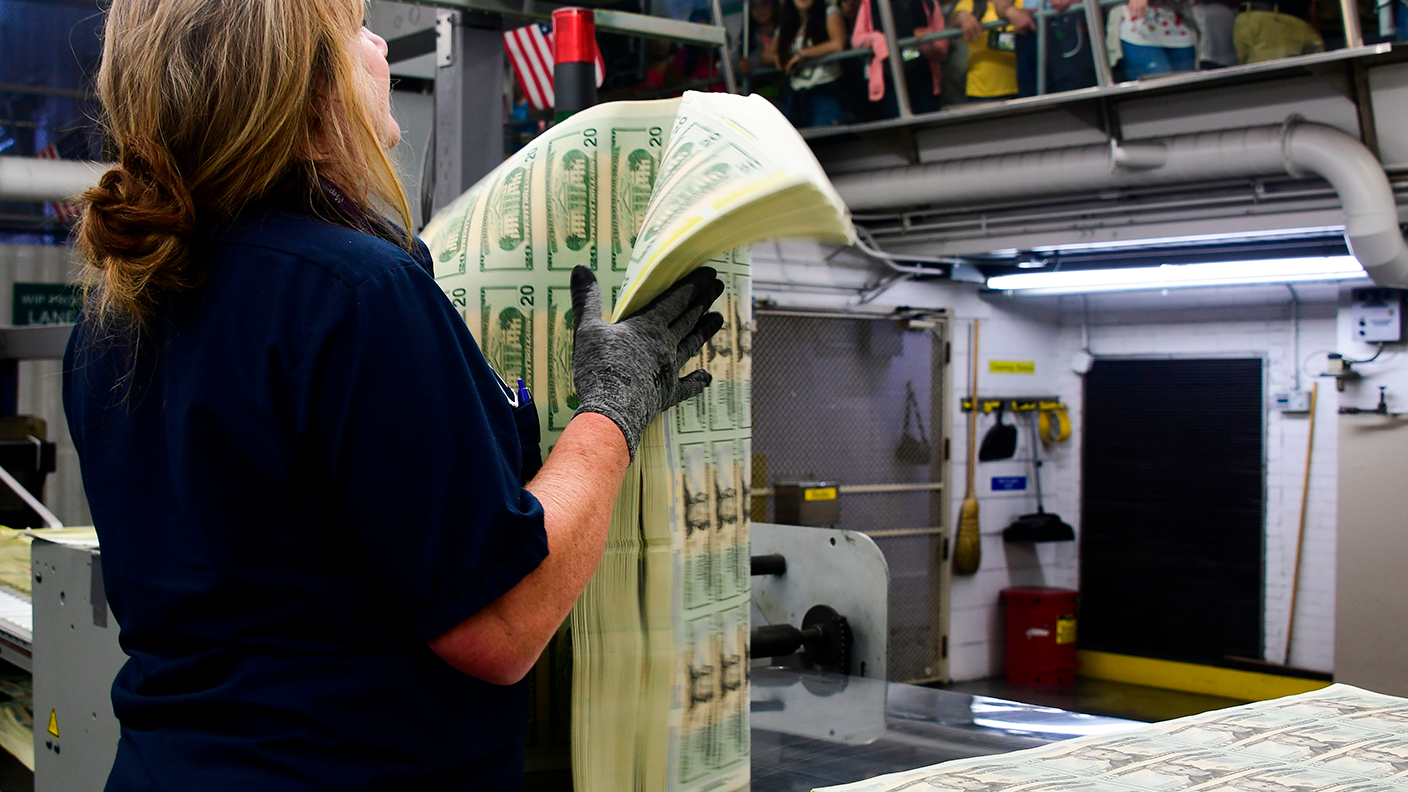A warning from history about the return of inflation
The message from past crises is clear: money-printing on the scale we’re seeing it now brings inflation. And while that might feel good at first, says Dominic Frisby, the endgame is grim.


In 1974, inflation of more than 10% gripped the US. President Nixon had unpegged the dollar from gold three years earlier; the oil price had risen by 400%; prices were out of control.
An American lawyer by the name of Ronald H. Marcks decided to write a book about inflation, specifically the spectacular episode that all but destroyed Germany in the early 1920s and the American inflation that had steadily gained force since 1962.
He couldn’t get a publisher, so he decided to self-publish, and 1,000 copies of Dying of Money – Lessons of the Great German and American Inflations were printed.
MoneyWeek
Subscribe to MoneyWeek today and get your first six magazine issues absolutely FREE

Sign up to Money Morning
Don't miss the latest investment and personal finances news, market analysis, plus money-saving tips with our free twice-daily newsletter
Don't miss the latest investment and personal finances news, market analysis, plus money-saving tips with our free twice-daily newsletter
Marcks didn’t want to upset any of his clients and so he did it under a pseudonym – Jens O. Parsson was the name he chose.
Writing under a pseudonym limits the extent to which you can promote, and the book never became a household name. Even today there is no Wikipedia entry. But copies lurked in libraries, PDFs changed hands on the net and the book never went away. And a good thing too, because it’s terrific.
What’s more, its message is extremely pertinent to today.
Why we need to re-educate ourselves on inflation
Paperbacks are trading hands on Amazon for over $800, so, good though it is, I don’t recommend you rush out and buy a copy. However, I’m going to quote a couple of passages here and let’s see how true they ring to this strange Covid world around us.
Inflation and deflation are slightly ambiguous terms that mean different things to different people. When definition is not clear, dispute often follows and so it is with inflation and deflation. Economists are forever arguing about which it is we are experiencing, when, often, they mean different things by the terms. As a result we now have terms like “stagflation”, “disinflation” and “reflation”.
Originally, inflation meant a growth in the supply of money and credit, with the consequence of higher prices. As you would inflate a tyre or a dinghy, so you inflate the money supply. The consequence of more money is higher prices. Deflation meant the opposite. Less air in the dinghy – with the result that it sinks.
To most economists, inflation simply means rising prices, and deflation means falling prices. They don’t look at the amount of air in the dinghy, just at how high or low certain waves go.
Rising and falling prices are defined by measures such as CPI. But the Consumer Price Index, to give it its full name, only measures the prices of certain consumer goods and services.
It doesn’t measure house prices, copper prices, share prices and many of the other prices that feature in our lives. These prices, what’s more, are prone to the deflationary forces of improved productivity and distribution and market competition, which push things down.
Research by Positive Money shows that only about 13% of newly created money and credit actually goes into the goods and services measured by CPI. So CPI is not a true measure of inflation.
The extraordinary money supply created by central banks in the post-2008 era did not make its way into the real economy and CPI was fairly muted over the period. Instead, the money made its way into financial assets – where there most certainly was inflation. Ordinary Joe in the real economy, however, did not see any of the “benefits”.
Today, though, via furloughs, loans and all the other means of bailing out the Covid crash, the money is, very definitely, going into the real economy. And it’s starting to look like this time it will show.
You’d think the economy was booming. Stocks are up, commodities are rising and the biggest inflation canary of the lot, silver, is going ballistic, up almost 30% in little more than a week.
I’m even noticing signs of inflation in the supermarkets – far fewer “3 for 2” deals, reductions and other bargains. Many people, as a result of not spending during the lockdown, are actually feeling cash rich. This is something of a crack-up boom: inflation is here.
So, to Parsson.
Inflation feels good at first – but the endgame is grim
“Everyone loves an early inflation,” Parsson says. “The effects at the beginning of an inflation are all good. There is steepened money expansion, rising government spending, increased government budget deficits, booming stockmarkets, and spectacular general prosperity, all in the midst of temporarily stable prices. Everyone benefits, and no one pays. That is the early part of the cycle.”
This is what we are experiencing now. It’s what, according to Parsson, comes next that we should all be worrying about:
“In the later inflation, on the other hand, the effects are all bad. The government may steadily increase the money inflation in order to stave off the later effects, but the later effects patiently wait.
“In the terminal inflation, there is faltering prosperity, tightness of money, falling stockmarkets, rising taxes, still larger government deficits, and still roaring money expansion, now accompanied by soaring prices and ineffectiveness of all traditional remedies.
“Everyone pays and no one benefits. That is the full cycle of every inflation.”
The question is whether Parsson’s bad inflation will ever manifest.
Nothing is ever as simple as it seems in a book. Real life has twists and turns and false signals galore. But take a step back from the daily noise and consider the long-term picture, and Parsson’s description seems rather apt.
Will central planners be able to manage the later, bad inflation (assuming it comes)? After 2008, their confidence is surely up. My view is that they got away with it then – they dodged a bullet. They might not get so lucky this time round.
To Parsson again: “Scarcely a person … was untouched by inflation's handiwork. Every citizen, in his daily life and with his earthly fortune, danced to a tune he mostly could not hear, played for him by the government's inflation.
“It was up to every citizen to learn for himself what was happening and to look out for himself if anyone was going to, because no one else was looking out for him. The government certainly was not.
“The government was compelled by its other duties not to protect him but the opposite, to continue to steal from him by the inflation as long as it could. The forces at work were such that there was no practical possibility the inflation would end or abate".
If Parsson is right, the government’s priority is not you, it is itself. It is its predicament and staying in power. If it needs to debase its currency to do that, it will. The way to protect yourself from the government debasement is via non-government money. Every penny you put into gold or bitcoin is a penny that government can’t debase.
We thought the bad inflation was coming after the post-2008 money print, but it never quite came. If inflation “patiently waits” as Parsson suggests, then perhaps its time is coming now. The gold and silver price action certainly suggests that it is.
Daylight Robbery – How Tax Shaped The Past And Will Change The Future is available at Amazon and all good bookstores with the audiobook, read by Dominic, on Audible and elsewhere. If you want a signed copy, you can order one here.
Get the latest financial news, insights and expert analysis from our award-winning MoneyWeek team, to help you understand what really matters when it comes to your finances.
Dominic Frisby (“mercurially witty” – the Spectator) is as far as we know the world’s only financial writer and comedian. He is the author of the popular newsletter the Flying Frisby and is MoneyWeek’s main commentator on gold, commodities, currencies and cryptocurrencies. He has also taken several of his shows to the Edinburgh Festival Fringe.
His books are Daylight Robbery - How Tax Changed our Past and Will Shape our Future; Bitcoin: the Future of Money? and Life After the State - Why We Don't Need Government.
Dominic was educated at St Paul's School, Manchester University and the Webber-Douglas Academy Of Dramatic Art.
You can follow him on X @dominicfrisby
-
 What do falling interest rates mean for you?
What do falling interest rates mean for you?You may think that only businesses and politicians should pay attention to choices made by the Bank of England, but its interest rates decisions also have an impact on your personal finances. We explain how.
-
 Halifax: UK house prices at lowest level since summer as growth slows
Halifax: UK house prices at lowest level since summer as growth slowsProperty prices fell by 0.6% month-on-month in a typical Christmas season slowdown, Halifax’s latest house price index shows.
-
 UK wages grow at a record pace
UK wages grow at a record paceThe latest UK wages data will add pressure on the BoE to push interest rates even higher.
-
 Trapped in a time of zombie government
Trapped in a time of zombie governmentIt’s not just companies that are eking out an existence, says Max King. The state is in the twilight zone too.
-
 America is in deep denial over debt
America is in deep denial over debtThe downgrade in America’s credit rating was much criticised by the US government, says Alex Rankine. But was it a long time coming?
-
 UK economy avoids stagnation with surprise growth
UK economy avoids stagnation with surprise growthGross domestic product increased by 0.2% in the second quarter and by 0.5% in June
-
 Bank of England raises interest rates to 5.25%
Bank of England raises interest rates to 5.25%The Bank has hiked rates from 5% to 5.25%, marking the 14th increase in a row. We explain what it means for savers and homeowners - and whether more rate rises are on the horizon
-
 UK inflation remains at 8.7% ‒ what it means for your money
UK inflation remains at 8.7% ‒ what it means for your moneyInflation was unmoved at 8.7% in the 12 months to May. What does this ‘sticky’ rate of inflation mean for your money?
-
 Would a food price cap actually work?
Would a food price cap actually work?Analysis The government is discussing plans to cap the prices of essentials. But could this intervention do more harm than good?
-
 Is my pay keeping up with inflation?
Is my pay keeping up with inflation?Analysis High inflation means take home pay is being eroded in real terms. An online calculator reveals the pay rise you need to match the rising cost of living - and how much worse off you are without it.
